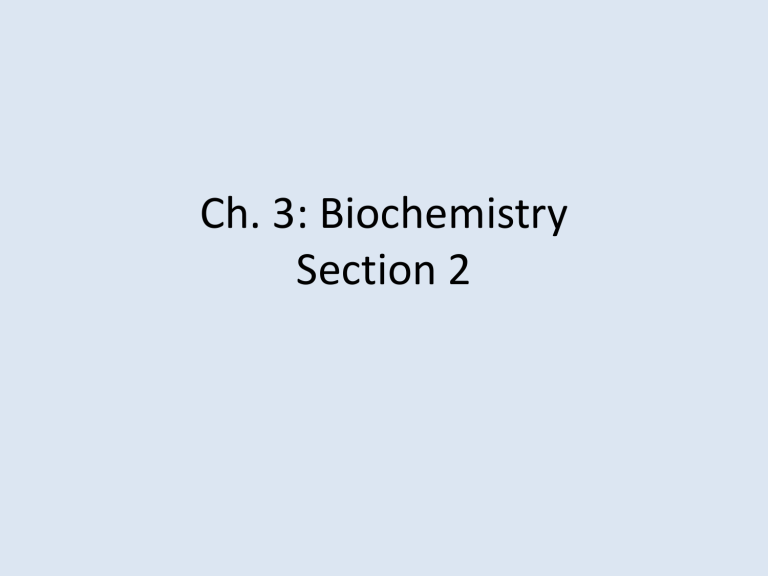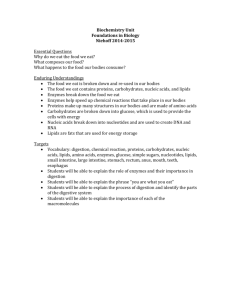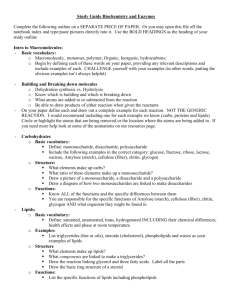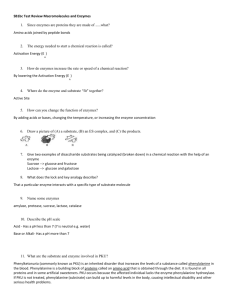Biochemistry - Cloudfront.net

Ch. 3: Biochemistry
Section 2
Molecules of Life
• Four main classes of organic compounds are essential for life processes of living things:
– Carbohydrates
– Lipids
– Proteins
– Nucleic Acids
Carbohydrates
• Carbohydrates- Organic compounds composed of carbon, hydrogen and oxygen
– 1:2:1 ratio
– Serve as sources of energy or structural components
– Monosaccharides, disaccharides, and polysaccharides
Carbohydrates
• Monosaccharides
– Simple sugar; 1:2:1 ratio of atoms
• Disaccharides
– Monosaccharides combine to form a double sugar
• Polysaccharides
– Complex molecule of 3 or more monosaccharides
Carbohydrates
Types of Polysaccharides
• Glycogen
– Animals store glucose in the form of glycogen
– Used for energy storage
• Starch
– Plants store glucose in the form of starch
• Cellulose
– Plants use cellulose as a structural component
– Gives strength and rigidity to plant cells
Proteins
• Proteins: composed mainly of carbon, hydrogen, oxygen, and nitrogen
– Formed by the linking of monomers called amino acids
– Ex: hair, horns, skin, muscles, enzymes (catalysts)
Proteins
• Amino Acids
– 20 different amino acids
– All share the same basic structure
• Central carbon
• Single hydrogen
• Carboxyl group (--COOH)
• Amino group (NH
2
)
• R group (what distinguishes different amino acids)
Proteins
• R groups
– Can be simple or complex
– Differences among the R groups of amino acids gives proteins their different shapes
– Different shapes allow proteins to carry out many types of activities
Proteins
• Dipeptide
– Two amino acids linked together through a peptide bond
• Polypeptide
– Long chains of amino acids
– Polypeptide chains and resulting proteins can have different shapes depending upon types of bonds, temperature, solvents, etc.
Proteins
• Enzymes
– RNA or protein molecules that act as biological catalysts
– Essential for any cell to function properly
– Many enzymes are proteins
Proteins
• Enzymes
– Enzyme reactions depend on a physical fit between the enzyme and its specific substrate, the reactant being catalyzed
– Enzymes have folds, called an active site, where the substrate fits.
– Only specific substrates are acted upon
• Only that substrate fits in that active site
Proteins
• Enzymes Continued
– Enzymes bind to a substrate, the enzyme changes shape slightly weakening bonds of substrate
• One way enzymes reduce activation energy
– Once reaction is completed, the enzyme releases the new product
– IMPORTANT: the enzyme itself remains unchanged, and can be used many times
Enzyme Reaction
Lock and Key
Lipids
• Lipids: large, nonpolar organic molecules
– Include triglycerides, phospholipids, steroids, waxes, and pigments
– Do not dissolve in water
– Large amounts of C-H bonding means they store more energy per gram than any other macromolecule per
Lipids
• Fatty Acids
– Unbranched carbon chains that make up most lipids
– The two ends of a fatty acid have different properties
• Head (carboxyl group C-
O-O-H) is hydrophilic
(water loving)
• Tail (C-H chains) are
hydrophobic (water hating)
Lipids
• Saturated vs. Unsaturated
Lipids
• Triglycerides
– Three fatty acids attached to an alcohol glycerol
– Can be saturated and unsaturated
Lipids
• Phospholipids
– Two fatty acids attached to a glycerol molecule
– The cell membrane is made up of two layers of phospholipids, called the lipid bilayer
– Hydrophobic tails and hydrophilic heads
• Forms a barrier between outside and inside of cell
Lipids
• Waxes: waterproof, and help provide a protective coating for plants’ outer surfaces.
– Human ex: ear wax helps protect ear canal
• Steroids: Fused carbon rings; many animal hormones are steroids. Most common animal hormone is cholesterol
Nucleic Acids
• Nucleic Acids: very large and complex molecules that store and transfer information in the cell
– DNA: contains info about characteristics or organisms and directs cell activities
– RNA: stores and transfers info from DNA in order to manufacture proteins. Can also act as enzymes
• Nucleotide: made of sugar, nitrogenous base, and phosphate group








